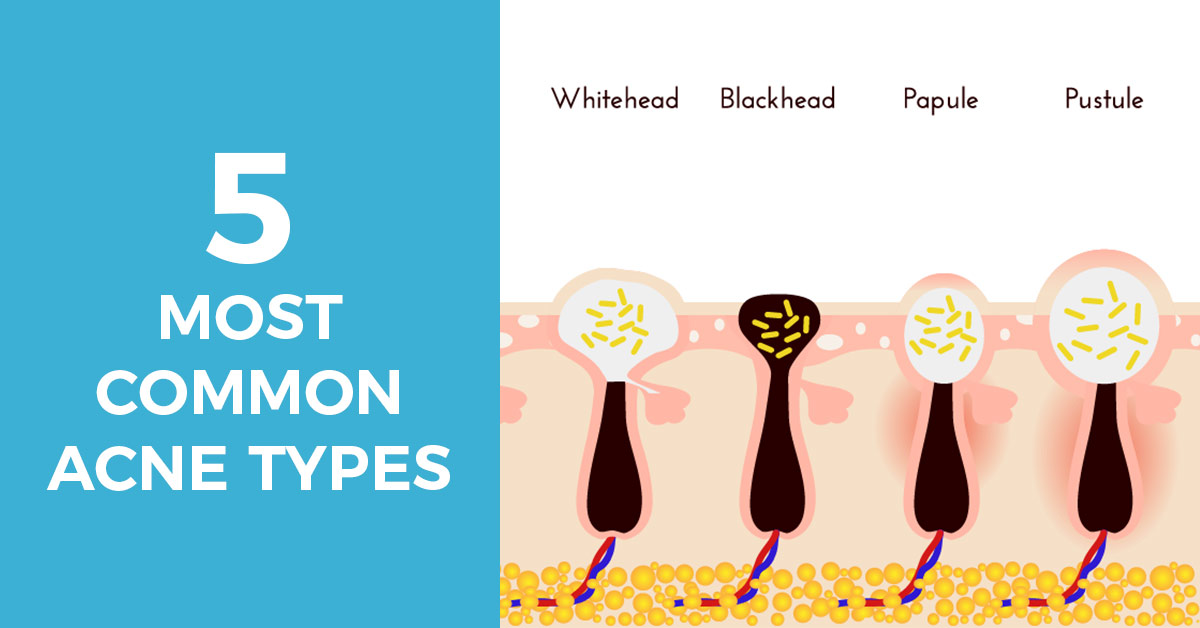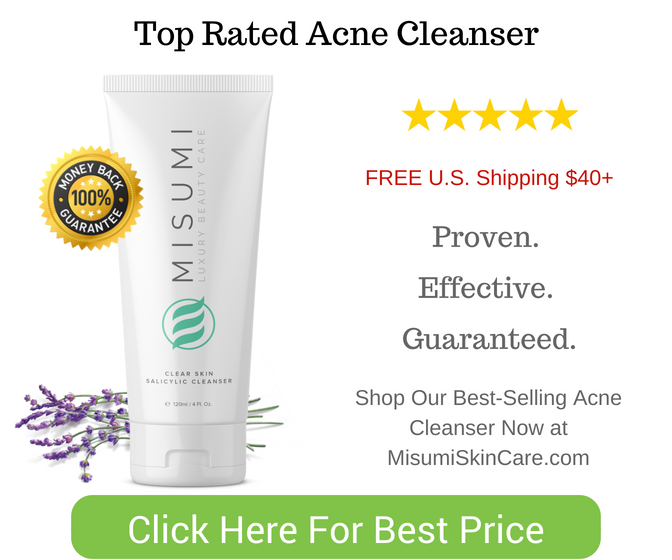Contents
If you’re reading this, chances are you’ve had to deal with some sort of acne at some point in your life.
If you’re lucky, it may have just been a phase when you were a teenager. But if you’re anything like me, it’s something you’ve had to fight against on and off, long after you’ve left your teenage years behind.
Age aside, acne is something 50 millions of Americans deal with every year. According to the American Academy of Dermatology, acne is the single most common skin disorders in the United States.
“Just like snowflakes, no two pimples are alike.”
Despite being such a widespread problem, many are still in the dark when it comes understanding this unsightly, yet commonplace problem.
How much do you know about acne? Keep reading, and we’ll take a deeper look at different types of acne and help you quickly identify them.

What is acne?
Acne occurs when inflammation or infections take root in your pores, or hair follicles. This happens when the follicles become clogged.
Often time pores become clogged with oil secreted by the sebaceous glands. The severity of the clog, along with the subsequent infection, will dictate the type of acne as we’ll learn a little later.
Touching your face or other acne-prone areas can also lead to further blemishes. When you touch your skin, oil from your fingers transfers and can further clog pores.
Among the most common causes of acne are hormones. Hormones are responsible for increased oil production, which in turn increases breakouts. Changes in hormones also explain why those going through puberty, as well as women on birth control, often see an increase in breakouts.
TIP: Check out our comprehensive guide – how to get rid of acne!
VIDEO: How are blackheads formed and how to get rid of them
Because there are such varied reasons for acne, it can hit at any time. Even babies aren’t exempt. From acne neonatorum, which affects newborns, to adult-onset acne, breakouts are something that at one point or another, happens to everyone.
Salicylic Acid: Breaking Up Blackheads
Did you know there are upwards of ten different types of acne? While ranging in severity and occurrence, acne is no straightforward topic. Today we’re going to cover the five most common acne conditions.
Acne can be broken down into two main categories; inflammatory and noninflammatory. Within these categories are where we’ll find the different variations.
You may be asking yourself “What kind of acne do I have?” Keep reading to find out!
Non-Inflammatory Acne
Non-inflammatory acne is also known as comedonal acne. It’s one of the more common types of acne. Comedones (or Comedo-singular) are small bumps caused by clogged pores.
Your body naturally produces sebum from the sebaceous glands to nourish your skin and hair. Sometimes, and for many reasons, your body may produce excess 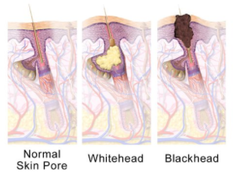 sebum which leads to clogged pores and eventually, comedonal acne.
sebum which leads to clogged pores and eventually, comedonal acne.
Comedonal acne can appear anywhere on the body but are most commonly appear on the facial area, particularly on the nose and chin. The degree of the clog will determine if they become whiteheads or blackheads.
Whiteheads
As the name implies, whiteheads appear white in color. Whiteheads are clogged hair follicles or pores where sebum (otherwise known as oil) or dead skin cells have plugged the follicle or pore. The contents of the pore are not openly exposed, which leads to the raised appearance. The raised bump is not red in color and swelling is at a minimum.
Blackheads
Blackheads, like whiteheads, get their name from their appearance. 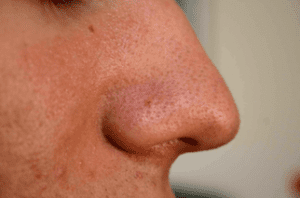 Where whiteheads are enclosed comedones, blackheads are pores that are clogged, and the contents are exposed. Exposure to the air causes the oil and debris to darken and appear “black.”
Where whiteheads are enclosed comedones, blackheads are pores that are clogged, and the contents are exposed. Exposure to the air causes the oil and debris to darken and appear “black.”
Inflammatory Acne
Unlike blackheads and whiteheads, inflammatory acne develops deeper below the skin surface. Often, the inflammation will begin at the base of a clogged hair follicle and will become infected.
Inflammatory acne is among the types of acne where bacteria is the main culprit
Papules
Often considered to be the cousin of whiteheads, papules are classified by their small to medium and appearance as well as redness and swelling. 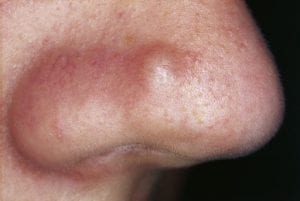 Papules exist when follicles become clogged with sebum, bacteria and old skin cells.
Papules exist when follicles become clogged with sebum, bacteria and old skin cells.
The primary indicator you may have a papule is the lack of pus or white tip. Because the papule is caused by inflammation, it’s best to avoid applying any drying medication to this type of acne.
Pustules
When you have a pustule, you’ll know it. Pustules are red, swollen bumps and are often white or yellow in the center. Unlike papules, pustules contain pus (hence the name!)
Pustules are the result of a ruptured follicle. The body tries to repair the damage by sending white blood cells to the site, which creates pus. 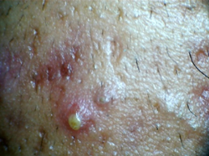
It may be hard to resist squeezing a pustule, but it should be avoided because it can lead to scarring down the line. At the very minimum, extraction shouldn’t be attempted until a white or yellow head is visible.
Pustules are often painful to the touch and resemble an inflamed whitehead. When someone thinks of a “stereotypical” pimple, they usually are referring to a pustule.
Cysts and Nodules
Cysts and nodules are among the more severe types of acne. They can be more painful and harder to treat than other types of acne. Many times, these types of acne require a doctor’s advice or prescription medication to treat successfully. Because these types of severe acne are rooted deep under the skin, the potential for scarring and infection are much higher than other types of acne.
Nodules are essentially hard papules that are buried much 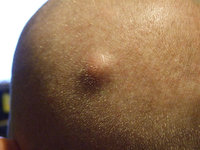 deeper beneath the skin surface. You should never squeeze nodules as it can cause the breakout to spread. What makes nodules even more tricky is that they can lie dormant for periods of time and can make a resurgence at any time.
deeper beneath the skin surface. You should never squeeze nodules as it can cause the breakout to spread. What makes nodules even more tricky is that they can lie dormant for periods of time and can make a resurgence at any time.
Cysts or cystic acne is (in my opinion) one of the most frustrating types of acne. Cysts occur much like nodules, but instead of the infection remaining inside the follicle, it spreads to the surrounding tissue.
This particular type of acne appears as a hard, pus-filled sac that is deep under the skin. It’s often visible as a red lump which can be quite painful to touch. If the cyst ruptures, it can cause a troublesome infection of the surrounding tissue.
Cystic acne requires treatment by a professional dermatologist. Left untreated, cystic acne can lead to a variety of problems, least of all scarring.
Countless studies delve into the effects of acne on one’s well being. I know first hand how tough it can be to deal with an outbreak, especially when you have a big event coming up. It can be hard to put your best face forward when your confidence is low.
The good news is that acne is treatable! From over-the-counter treatments to prescription medications, acne is something that can be managed. If acne has you down, seek professional advice.
Tips to avoid acne
- Avoid touching your face. The excess oil on your fingers can further clog pores as well as adding bacteria to open pores.
- Wash your face regularly but DON’T scrub! Excessive scrubbing can strip away the “good” oil and cause your skin to overproduce sebum which can lead to further breakouts.
- Keep stress levels down. There’s an obvious link between breakouts and stress so try to stay calm whenever possible.
- Drink water. And lots of it! Water helps detoxify your system and can help you get that clear skin you always wanted!
- Avoid popping or squeezing existing acne. This will only lead to scarring or spreading acne. Resist the temptation!
The takeaway
Different types of acne require different forms of treatment, but all will take some patience on your part. With so many forms of treatment available, no one needs to suffer from acne for long.
The first step is identifying which type of acne you have. Depending on the types of acne you’re dealing with, seeing a dermatologist may be helpful in clearing up your skin as soon as possible. Seeing a professional can also help reduce any potential scarring.
Have you been struggling with some of the types of acne above? Let us know in the comment section below how you’re dealing with acne!

